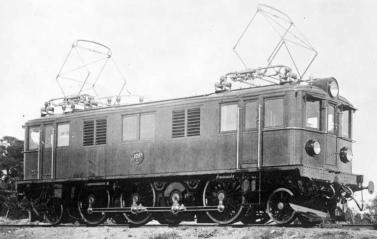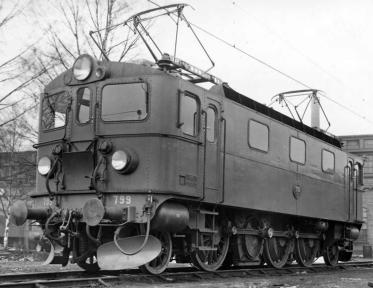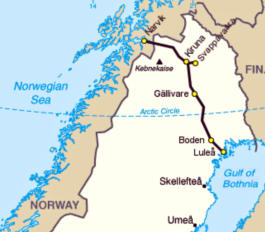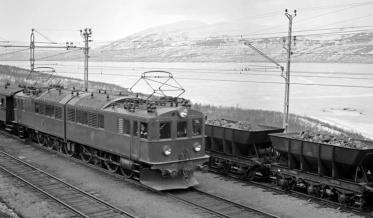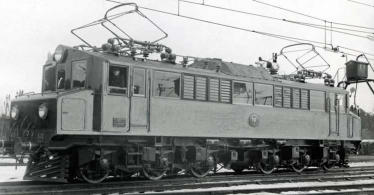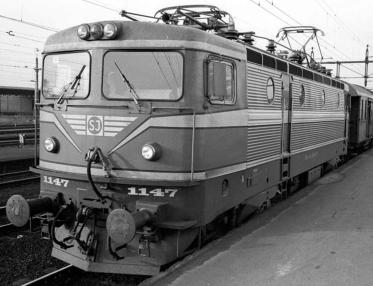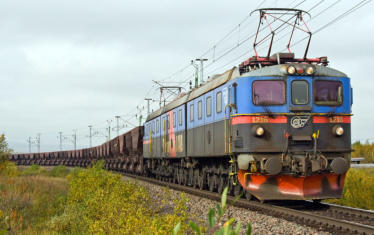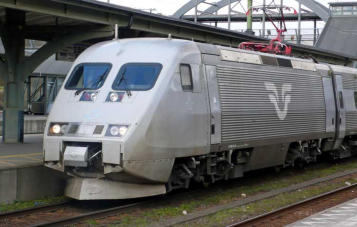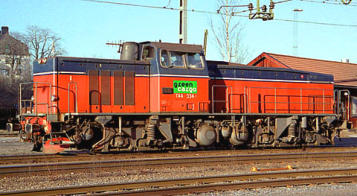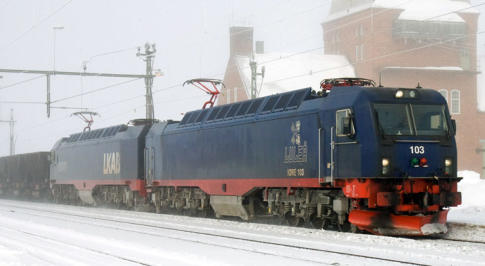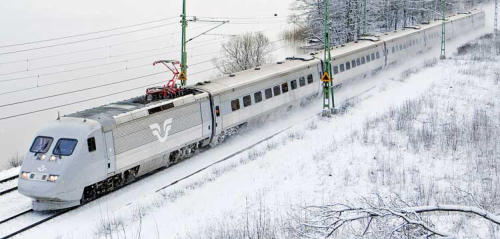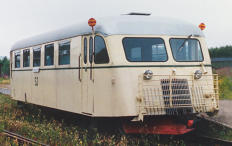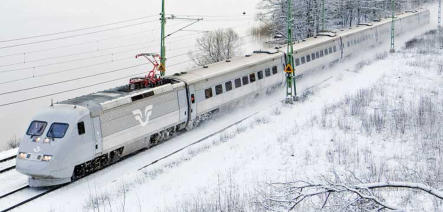
Copyright © Hans Högman 2021-03-18
History of Railways in Sweden (4b)

Swedish State Railways (SJ) -
Locomotives (2)
A locomotive or engine is a rail transport vehicle that
provides the motive power for a train. Traditionally,
locomotives pulled trains from the front. The term
"engine" is often used as an alternative to locomotive.
A motor coach (UK) or motorcar (US usage) is a
powered rail vehicle able to pull several trailers and at
the same time transport passengers or luggage.
Locomotives may generate their power from fuel
(wood, coal, petroleum, or natural gas), or they may
take power from an outside source of electricity. It is
common to classify locomotives by their source of
energy. Although historically steam propulsion
dominated, the most common types of locomotives
are diesel and electric, the latter supplied by
overhead wires or additional rails.
Motive power for a train is provided by a separate
locomotive or individual motors in self-propelled
multiple units. A train is a form of rail transport
consisting of a series of connected vehicles that
generally run along a railway (or railroad) track to
transport passengers or cargo (also known as
"freight" or "goods").
Passenger trains include passenger-carrying vehicles
and can often be very long and fast. Goods (Freight)
trains use freight wagons (or cars/trucks) to
transport goods or materials (cargo). It is possible to
carry passengers and freight in the same train using a
mixed consist.
A train driver, engine driver, or locomotive driver is a
person who drives a train.
Most of the locomotives and carriages/wagons used
on Swedish rails are also produced in Sweden.
Prince August was the first locomotive (B-class) in
the service of the Swedish State Railways,
manufactured by Beyer, Peacock & Co, Manchester
(UK). The locomotive was used to pull mixed trains on
the Southern Main Line. Six locomotives were
acquired from the UK in 1856. Three served on the
Western Main Line and three on the Southern Main
Line; Prince August, Prince Carl, Prince Oscar.
However, a domestic locomotive-manufacturing
industry was quickly established in Sweden.
In total, 45 so-called B-class locomotives were
acquired by SJ between 1856 and 1872, 23
manufactured in the UK and the rest in Sweden. The
first B-class locomotive, Prince August, was in use
until 1906 and remains in the Swedish Railway
Museum in Gävle.
However, the first locomotive manufactured in
Sweden was Förstlingen (“The Firstling”), which was
made by Munktell AB, Eskilstuna, in 1853.
In 1925, the first electric locomotive (D-class) was
introduced by SJ. It was manufactured by ASEA,
Sweden. In total, 333 D-class engines were produced.
Steam Locomotives, Electric Locomotives, Diesel
Locomotives, Locomotives - start
Electric Locomotives
An electric locomotive is a locomotive powered by
electricity from overhead lines, a third rail, or on-
board energy storage such as a battery or a
supercapacitor. Electric locomotives benefit from the
high efficiency of electric motors, often above 90%.
The first electric locomotive in Sweden was the
Starkotter in Robertsfors which was built in 1900. The
electrification of the railways began early in Sweden.
The Swedish State Railways (SJ) began testing
locomotives powered by electricity in 1905 on the
Värtan Line (Swe: Värtabanan) in Stockholm.
In 1915, the first Swedish electrified railway line for
passenger traffic operated by SJ opened, hauled by
electric locos. An early electrified line for the
transport of passengers was the Djursholm
(Djursholms banan) in Stockholm, a commuter line
that opened in 1895.
Other countries, early with electrified railway lines
are the USA, Germany, and Switzerland.
At the end of the 1900s, almost all new locomotives
for passenger transport ordered in Sweden are
motor coaches. A motor coach (International) or
motorcar (US) is a powered rail vehicle able to pull
several trailers and at the same time transport
passengers or luggage. A motor coach is
distinguished from a railbus by not being lightweight.
However, electric locomotives are still used for the
rail transport of goods. In Sweden, diesel
locomotives are foremost used on minor lines or
lines not electrified.
Locomotive classes:
The SJ electric locomotive classes:
•
D - From 1936, electric locos without bogies, but
with coupling rods between the driving axle on
each side.
•
M - Electric locos, with three-axle bogies, used on
goods trains. This designation was previously also
used for steam locomotives.
•
O - Early electric locos for the Iron Ore trains. This
designation was previously also used for steam
locomotives.
•
R - Electric locos, with two-axle bogies, used on
passenger and goods trains.
•
X - Electric motor coaches. This designation was
between 1878 and 1879 also used for steam
locomotives.
Each piston is attached to the driving axle on each
side by a connecting rod, and the driving wheels are
connected together by coupling rods to transmit
power from the main driver to the other wheels.
Each piston transmits power through a crosshead,
connecting rod (Main rod (US)) and a crankpin on the
driving wheel (Main driver (US)) or to a crank on a
driving axle.
A bogie (truck (US)) is a chassis or framework that
carries a wheelset, attached to a vehicle—a modular
subassembly of wheels and axles. Most bogies have
two axles, but some cars designed for heavy loads
have more axles per bogie.
Below is a listing of the most common types of
electric locomotives used in Sweden:
D-class:
The D-class locomotives are the second most
manufactured electric locomotives in Sweden and
were the first SJ standard electric locomotive. It was
developed in connection with the electrification of
the Western Main Line. Between 1925 and 1943, 333
D-class locomotives were manufactured by ASEA,
Sweden. In the 1950s, a new version of the
locomotive was produced, designated Da and Dm-
class. Between 1967 and 1988, these electric
locomotives were replaced by the new Rc-class
locomotives.
The first 134 D-class locos, manufactured between
1925 and 1933, were delivered with a wooden body,
but in 1933 replaced with steel construction.
The difference between the various sub-class
divisions of the D-class locomotives are functions,
not appearance. For example, geared and optimized
for goods trains or passenger trains. However, the
difference between passenger and freight locos
disappeared with the Du-class version since this
variant was capable of 100 km/h (62 mph) and still
haul goods trains. The Du became a universal
locomotive, however in the end mainly used for
goods trains. It retired from service in 1977.
The image shows an SJ D-class electric locomotive, D
108, with a wooden body, in 1926. Image:
Järnvägsmuseet, ID: JvmKACA00655.
Ds was one of two original D-class variants, geared
for passenger traffic. Initially, the maximum speed
was set to 90 km/h but in 1936, the maximum speed
was increased to 100 km/h. The production was
closed down when a newer variant was developed
with a more powerful engine, designated Dk with a
maximum speed of 100 km/h. The then existing Ds
locomotives were gradually rebuilt to Dk standard.
Dg was the other of the two original D-class variants,
geared for goods traffic with a maximum speed of 70
km/h (43 mph).
The Da locomotives were developed in the 1950s
and equipped with a new engine. 93 Da locos were
produced by ASEA between 1952 and 1957 and these
93 Da locomotives became SJ:s new universal
locomotive, used for both passenger and goods
traffic.
Also, the original D-class locomotives were upgraded
to the new engine and re-designated Du. After this
upgrade, there was no longer any difference
between passenger and goods locomotives since all
locomotives now were geared for 100 km/h. The Du
locomotives were used until 1977.
The last of the newer Da locomotives served until
1990–1995.
The image shows an SJ Da-class locomotive, Da 799,
with a steel body, in 1957. Photo: Seved Walther.
Image: Järnvägsmuseet, ID: JvmKDAF04883.
A new class of electric locomotives was developed at
the end of the 1960s, the Rc-class locomotives. To
use D-class locomotives together with Rc
locomotives, the Du locomotives were equipped with
a new multiple coupling box to make it possible to
couple Rc and Du locomotives. These upgraded Du
locomotives were then re-designated Du2 and the
upgrade was done between 1967 and 1976.
D-class, loco length 13 meters (42 ft 8 in), loco weight 80
tons, driving wheel diameter 1530 mm (60.2 in). Power
output: 1.220 kW (Ds, Dg).
The Da locomotives, length 13 meters, loco weight 75
tons. Power output: 1.840 kW.
The Dm and Dm3 locomotives were a special D-class
variant developed to haul iron ore trains on the Iron
Ore Line from the iron ore mines in Kiruna and
Malmberget to the ports in Swedish Luleå on the
Baltic coast and Norwegian Narvik on the Atlantic
coast. The Dm locomotive, later equipped with a
center-section designated Dm3, are two variants of
the same locomotive. As initially developed, the twin-
section Dm-class locomotives were capable of pulling
up to 3,400 tons of ore trains. However, due to
progressive increases in train size and weight, this
was no longer acceptable by the end of the 1960s.
Therefore SJ ordered 19 new cab-less center
locomotives, which were installed permanently
between the two halves of a Dm class locomotive;
the resulting rebuild being designated Dm3. With the
addition of the center locomotive, the Dm3 class
locomotives were able to haul trains up to 5,400 tons
(54 hopper wagons, 100 tons each).
A total of 39 Dm double-locomotives (2*39) were
delivered between 1953 and 1971, built by ASEA. A
further 19 center locomotives (Dm3) were delivered
between 1960 and 1970. In 2001, the Dm3-locos
were gradually being replaced by the new Iore-class
locomotives, but Dm3 locos were in service until
dock 2013.
Loco length over the buffers: 25.1 m (Dm) respective
35.2 m (Dm3). Loco weight: 190 tons (Dm), 273.2 tons
(Dm3). Maximum allowed speed: 75 km/h. Power
output: 4,800 kW (Dm), 7,200 kW (Dm3).
The image shows a Dm3-locomotive, Dm3 1216, on
the Iron Ore Line, near Kiruna, North Sweden, in
2006. Image: Wikipedia.
O-class:
The first electrified railway line of the Swedish State
Railways (SJ) was the Kiruna–Riksgränsen section of
the Iron Ore Line which was electrified in 1915. The
electrification of the entire Iron Ore Line was finished
in 1923. The ore line is a 500 km (300 mi) long
railway line between Luleå-Gällivare-Kiruna-
Riksgränsen in Sweden and to the port of Narvik in
Norway. The Norwegian section of the ore line is
called Ofotbanen. The Swedish mining company
LKAB transports iron ore on the ore line from the
mines in Kiruna and
Malmberget to the ports
in Narvik (Norway) and
Luleå (Sweden) for
export to other
countries.
The image shows a map
of the Iron Ore Line in
North Sweden. Image:
Wikipedia.
The Oe and Of locomotives were a series of electric
locomotives that SJ used to haul iron ore trains on
the Iron Ore Line. The Oe locomotives were delivered
in 1922 and the Of in 1924. The Oe/Of locomotives
were designed as coupling-rod locomotives and built
as twin-coupled locomotives. Between 1937 and
1944, the Oe locomotives were upgraded to the
same standard as the Of locos and then designated
Of2. The last Of/Of2 locomotives were retired in
1972. All these double locomotives had a wooden
body. Between 1953 and 1961, nine double
locomotives were temporally rebuilt to six triple
locomotives designated Of3.
On the section Kiruna-Narvik, the Of3 locomotives
were permitted to haul iron ore trains up to a total
weight of 3,100 tons while the Of/Of2 locomotives
could haul at the most 2,250 tons.
The image shows twin-coupled “Of” electric
locomotives, SJ Of 93 & 94, in 1950. The Of-
locomotives are hauling empty ore wagons returning
to Kiruna meeting an ore train with hopper wagons
loaded with iron ore. Photo: Eric Lundquist. Image:
Järnvägsmuseet, ID: JvmKBDN00941.
Oe-locos: length over the buffers 20.9 meters (68.6
ft), driving wheel diameter 1530 mm (60.2 in), loco
weight 126.8 tons, power output 2880 hp, traction
power 39 tons, maximum speed 60 km/h.
Of-locos: length over the buffers 20.9 meters (68.6
ft), driving wheel diameter 1530 mm (60.2 in), loco
weight 127.8 tons, power output 2800 hp, traction
power 40 tons, maximum speed 60 km/h.
Of2-locos: length over the buffers 20.9 meters (68.6
ft), driving wheel diameter 1530 mm (60.2 in), loco
weight 127.8 tons, power output 2800 hp, traction
power 40 tons, maximum speed 60 km/h.
Of3-locos: length over the buffers 31.3 meters,
driving wheel diameter 1530 mm (60.2 in), loco
weight 204.0 tons, power output 4200 hp, traction
power 60 tons, maximum speed 60 km/h.
M-class (Electric):
The Mg-class (originally M-class) locomotives were a
series of locomotives developed for SJ to be used on
the main lines in northern Sweden and to haul heavy
trains. The Mg-class locos were produced in the
1940s when the Northern Main Line was electrified.
The main lines in Northern Sweden usually ran on
winding and broken grounds which the lines in
southern Sweden rarely did, therefore, the northern
lines needed more powerful locomotives. The many
curves on the northern lines demanded bogie
locomotives and the Mg locos were equipped with
two three-axle bogies. The maximum allowed
speed was 80 km/h (50 mph).
The image shows an SJ M-class electric locomotive, SJ
M 612, in 1944. Image: Järnvägsmuseet, ID:
JvmKDAE08590.
Loco length over the buffers 16.8 meters (55 ft), driving
wheel diameter 1000 mm (39 in), loco weight 102 tons,
power output 2640 kW.
R-class (Electric):
The Rc-class locomotives are the largest produced
series of locomotives in Sweden. The Rc locomotives
is a universal locomotive used to haul both
passenger and goods trains in all parts of Sweden,
including the northern parts. In total, 366 Rc locos
were delivered to SJ between 1967 and 1988
replacing the older D-class locomotives.
The image shows an SJ Rc-class electric locomotive, SJ
Rc4 1147, in 1976. Image: Järnvägsmuseet, ID:
JvmKBDB14784:01.
Altogether there have been 7 variants of the Rc-
locomotive in Sweden plus two special variants such
as the freight locomotive Rm designed to haul iron
ore trains and the Rz.
The first Rc version was produced between 1967-
1968 with the designation Rc. Initially, the Rc-locos
was foremost used to haul passenger trains but later
also goods trains.
The second version, Rc2, was an improved Rc,
manufactured between 1969 and 1975. Rc3 is
identical with Rc2 besides gearing and was
manufactured between 1970-1971. Rc3 is geared for
160 km/h (99 mph) while Rc1, Rc2, Rc4 and Rc5 is
geared for 135 km/h (84 mph). Sweden’s most
common electric locomotive, Rc4, was produced for
SJ between 1975-1982. In total,130 Rc4 was
delivered. Rc5 was a further developed version with
extensive technique improvements and was
manufactured between 1982 and 1986. Rc6 differs
from Rc5 by being geared for 160 km/h like the Rc3.
40 Rc6 was manufactured for SJ between 1985 and
1988. Five Rc6 were re-geared to do 180 km/h (112
mph) and designated Rc7.
Rm is a special variant of Rc, manufactured in six
copies in 1977. Rm is heavier than the regular Rc
locomotives and built to haul iron ore trains. The
Rm locos were coupled three and three and were a
complement to the Dm3-locomotives. The Rm-locos
are equipped with emergency electromagnetic track
brakes, and automatic coupling boxes (SA3), and
geared for power rather than speed.
Maximum permitted speed: 135 km/h (Rc1,2,4 och
5), 160 km/h (Rc3 and 6), 180 km/h (Rc7), 100 km/h
(Rm).
Rc-locos: length over the buffers 15.5 meters (50.1 ft),
driving wheel diameter 1300 mm (51 in), loco weight 80
tons, power output 2,640 kW.
The Ra-class Rapid locomotives is a series of
electric locomotives foremost used to haul express
trains in Sweden. The first Rapid locos were
manufactured in 1955 and had a streamlined design.
They were equipped with halogen headlights. In
total, 10 Rapid locomotives were manufactured
between 1955 and 1961 and were in service until
1996. The maximum permitted speed was 150 km/h
(81 mph).
The image shows an SJ Rapid locomotive (Ra-class), SJ
Ra 994, in 1962. Image: Järnvägsmuseet, ID:
JvmKBDB12677:02.
Rapid locos: length over the buffers 15.1 meters (49.5
ft), driving wheel diameter 1300 mm (51 in), loco weight
65 tons.
IORE-class:
The IORE class locomotives are six-axle powerful
freight locomotives used to haul the heavy iron ore
hopper wagons on the Iron Ore Line in North
Sweden between the LKAB ore mines in Kiruna to
the port of Narvik, Norway, and the mines in
Malmberget to the port of Luleå, Sweden. Iore is an
acronym for “Iron Ore”.
Each Iore locomotive is named after places along the
line. The Iore locomotives are coupled two and two
(two single-ended locos) and with 120-tons hopper
wagons, the double-coupled locomotives can haul 68
wagons, in total 8,160 tons including the weight of
the locomotives. The ore trains are 750 meters long.
The older Dm3 locomotives were able to haul 52
wagons.
The ore trains are equipped with special coupling
boxes allowing heavier trains. With traction of 1,200
kilo-newtons (kN), the IORE locomotive is the world's
strongest locomotive.
LKAB is a Swedish mining company and the ore
trains haul ore from LKAB's mines in Kiruna,
Malmberget, and Svappavaara to the ports of Luleå,
Sweden, and Narvik, Norway. Traditionally the rail
transport of ore was operated by the State Railways.
In 1993, LKAB obtained permission to operate their
own trains in Sweden, and from 1996 in Norway. Rail
transport companies MTAB (MalmTrafik i Kiruna AB)
and MTAS (Norwegian counterpart) were established
in 1996 (a joint venture). However, LKAB purchased
the ore rail transport companies in 1999. The name
of the company today is LKAB Malmtrafik (meaning
LKAB Ore Transport.
LKAB's railway division Malmtrafik operates the rail
transport of ore with 34 Iore locomotives (or 17
pairs) built by Adtranz and its successor
Bombardier.
The 34 Iore locomotives were manufactured
between 2000 and 2010 for MTAB (LKAB Malmtrafik).
The image shows an MTAB Iore-class double-coupled
locomotive, MTAB 103 Luleå, hauling hopper wagons,
passing Vassijaure in 2009. Image: Wikipedia.
Loco length over the buffers 45.8 meters (two locos
coupled in pair), 22.9 meters (single loco), driving wheel
diameter 1250 mm, loco weight 180 tons (single loco),
360 tons (coupled in pair), power output 5 400 kW
(single loco), 10 800 kW (two coupled in pair), maximum
permitted speed 80 km/h (50 mph).
X-class:
X is a designation for train sets hauled by motor
coaches. A motor coach (UK) or motorcar (US) is a
powered rail vehicle able to pull several trailers and
at the same time transport passengers or luggage.
With multiple-unit train control, one operator can
control several "motor coaches", possibly even
combined with locomotives, efficiently in the same
train, making longer trains possible. Motor coaches
can replace locomotives at the head of local
passenger or freight trains.
A motor coach is distinguished from a railbus by not
being lightweight.
The X1-class is a series of motor coaches foremost
used for regional traffic. The X1 was used as a
commuter train in Stockholm between 1968 and
2011.
The X2-class is a series of electric motor coaches
being part of a concept of fast trains in Sweden
known as X 2000. X 2000 is a fast, tilting train
launched in 1990, operated by SJ, designed, and built
by ASEA, Sweden. Between 1989 and 1998, 44 X2 was
manufactured for SJ.
When it was introduced in 1990 it was a first-class
only train, second class was introduced 1995. The X
2000 top speed is 210 km/h (130 mph) but has
reached 276 km/h (171 mph) in a trial run with
double locomotives units in 1993. However, the
maximum speed permitted in regular traffic is 200
km/h (120 mph).
X 2000 is not a high-speed train, but very fast
compared to regular train services. It shares the
tracks with regular trains.
The image shows an X2-class motor coach, i.e. an
X2000 train, at Lund Central Station in 2008. Image:
Wikipedia.
Loco length 17.75 meters (58 ft 3 in), total train length:
164.2 m (539 ft) (6 carriages), power output 3,260 kW
(4,370 hp), weight 269–365 tons.
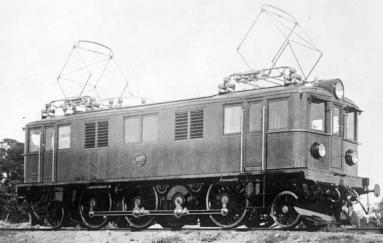
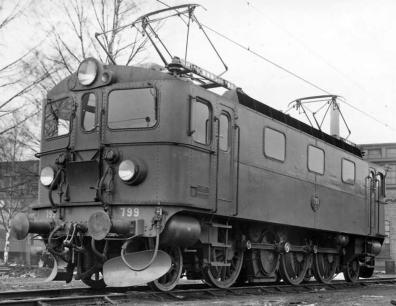
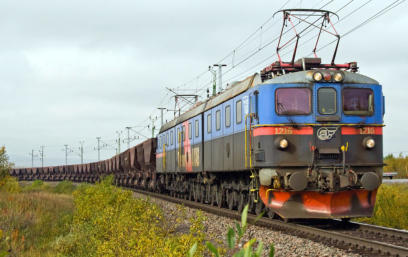


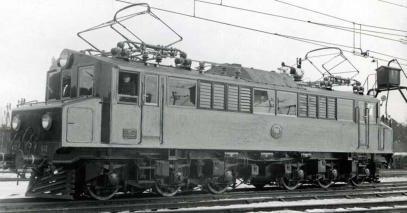
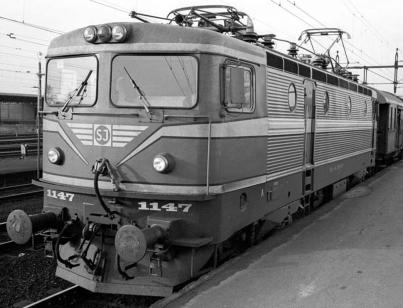

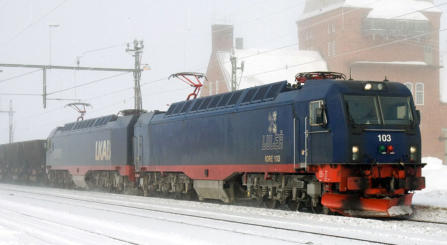
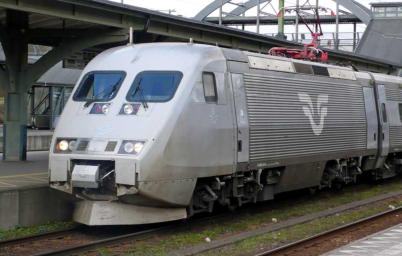
Railbuses:
A railbus is a lightweight passenger rail vehicle (motor
coach) that shares many aspects of its construction
with a bus, typically having a bus (original or modified)
body and four wheels on a fixed base, instead of on
bogies. Originally designed and developed during the
1930s, railbuses have evolved into larger dimensions.
Railbuses designed for use specifically on little-used
railway lines were commonly employed in many
countries, including Sweden.
A railbus usually has a cab at both ends which makes
it easy to change the direction of travel. The railbuses
are mostly electric but in some cases powered by
diesel engines.
The image shows a railbus, SJ Y7 1141, in Hallsberg,
1975. Image: Järnvägsmuseet, ID: JvmKDAJ09531.
The Swedish railway lines were electrified early.
However, there were many minor lines/branch lines
considered unprofitable to electrify. It was too
expensive to traffic these lines with steam
locomotives which is the reason for the introduction
of diesel-powered railbuses on these lines. In the
1920s there were several rail vehicles in service in
Sweden which were rebuilt road coaches, hence the
name - railbus. The first new-designed railbus in
Sweden was the Hilding Carlsson-railbus, which was
built in 1933. It was introduced on the Uppsala-Gävle
Railway.
The image shows a Hilding
Carlsson-railbus. Image:
Wikipedia.
The Carlsson railbuses
were replaced in the 1950s
by the SJ Y6-class
railbuses. This
orange/yellow railbus was very common and served
until the end of the 1980s. Between 1953 and 1960
fully 800 Y6 railbuses were manufactured.
When the Y6-class series of railbuses, including the Y7
and Y8, were retired they were replaced in 1979 by a
railbus built in Italy, designated Y1. In 2000, a set of
new Itino diesel railbuses (motor coaches) designated
Y31. the railbus was used by many regional railways in
Sweden.
Length over the buffers 17.55 m (57.6 ft), Maximum
permitted speed 115 km/h (71.5 mph) (Diesel), 110 km/h
(68 mph) (Electric). Number of seats: 53 (Y6), 47 (Y7), 36
(Y8) 55 (X16), 49 (X17), weight 19 tons.
Diesel Locomotives
The Swedish State Railways (SJ) used two designation
classes for the diesel locomotives, V-class (shunting)
and T-class (hauling and shunting).
A shunter, switcher, or shifter is a small railroad
locomotive used for maneuvering railroad cars inside
a rail yard in a process known as shunting (UK) or
switching (US). These locomotives are not intended
for moving trains over long distances but rather for
assembling trains at marshalling yards (UK) or
classification yards (US) for another locomotive to take
over. Shunters/switchers may also make short
transfer runs and even be the only motive power on
branch lines and switching and terminal railroads.
A diesel locomotive is a type of railway locomotive in
which the prime mover is a diesel engine. Several
types of diesel locomotives have been developed,
differing mainly in how mechanical power is conveyed
to the driving wheels. A diesel-mechanical
locomotive uses a mechanical transmission in a
fashion like that employed in most road vehicles.
In a diesel-electric locomotive, the diesel engine
drives either an electrical DC generator or an electrical
AC alternator-rectifier, the output of which provides
power to the traction motors that drive the
locomotive. There is no mechanical connection
between the diesel engine and the wheels.
In Sweden, diesel locomotives are foremost diesel-
electric locomotives.
Some examples of diesel locomotives in Sweden:
•
T43. About 50 built between 1961-1963.
•
T44. Further development of T43 is the most
common diesel loco in Sweden. 123 locos were
built between 1968-1987. Power output 1235 kW.
•
T46. An extended T44. 4 was purchased from av
LKAB between 1973-1974 for shunting service. It is
Sweden’s heaviest diesel loco.
T44:
T44 is a diesel-electric locomotive built by Swedish
NOHAB and KVAB in 123 units between 1968 and
1987 delivered to SJ. It was the successor of T43 and
used both for hauling good trains and shunting. It is
the most common diesel locomotive in Sweden, with
state-owned Green Cargo as the largest operator.
Compared to the predecessor T43-class, the T44 is
more powerful and has a modernized driver cab. In
2001, when the Swedish State Railways (SJ) was split
into several companies, Green Cargo took over all the
T44 locomotives.
Between 2009 and 2011, Green Cargo renovated 62
units of the T44 which included new four-stroke
engines. The renovated T44 units were re-designated
Td. The renovation was expected to extend the
lifetime by 15–20 years.
The image shows a diesel locomotive, T44, Green
Cargo. Image: Wikipedia.
Loco length over the buffers 15.4 meters (50.5 ft), driving
wheel diameter 1 030 mm (40.6 in), power output 1,235
kW (1670 hp), Loco weight 76 tons, maximum permitted
speed 100 km/h (62 mph).
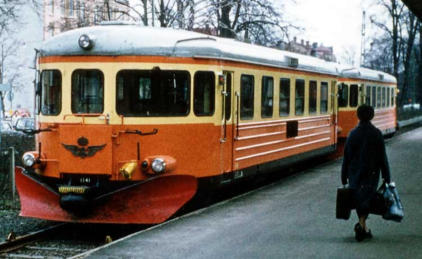



Related Links
•
Railway History, part-1
•
Railway History, part-2
•
Railway Occupations and Uniforms
•
Swedish State Railways - Locomotives-1
•
Iron Ore Line
•
Railway History - Images
•
Maps of the Swedish Railway System
•
History of Swedish Log Driving
Source References
•
Staten, järnvägarna och den regionala
utvecklingen i Sverige 1840–1890, Agaton Sten,
2015, Umeå Universitet.
•
Den glade rallaren? Norrbottniska rallares syn på
sina arbets- och levnadsvillkor, Per-Jonas Pihl
2016, Luleå Tekniska Universitet.
•
Boken “En rallares levnadsminnen”, av Samuel
Magnusson Svanbäck; nedtecknade av Herbert
Malmback, 1931.
•
Boken: “Banbrytare. Äventyr och upplevelser under
ett 100-årigt järnvägsbyggande i Sverige”. Manne
Briandt. Kristianstad 1959.
•
Sveriges järnvägars historia, Populär Historia, 13
september 2006 av Niklas Ingmarsson,
publicerad i Populär Historia 7-8/2006 .
•
Rallarna i Sverige banade väg för industrialismen,
av Mats Utbult, publicerad i Populär historia
11/2009.
•
Wikipedia
•
Järnvägsmuseet (Railway Museum in Gävle,
Sweden)
Top of page
An SJ X 2000 train running through a wintry
landscape by lake Aspen, Jonsered, Sweden in 2007.
Photo: Kasper Dudzik. Image: Wikipedia.





























































































































































































































































































































































































